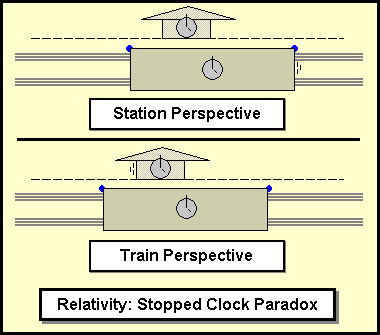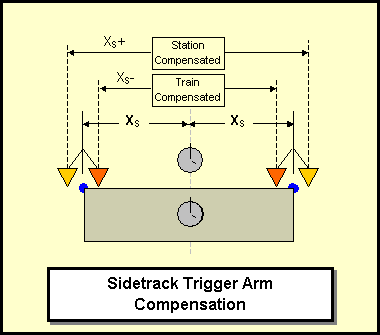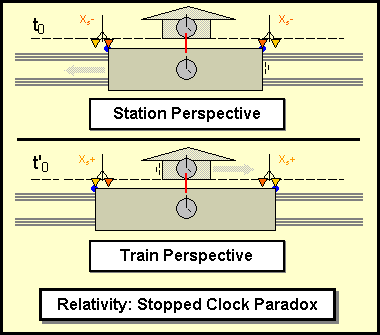The Stopped Clock Paradox establishes a scenario wherein a train with a special stop-clock is passing a station that has an identical stop-clock. The train’s stop-clock is mounted exactly in the center of a car and at the instant the two stop-clocks are aligned, flashers mounted fore and aft on that car are triggered by special sidetrack arms that touch the flashers as they pass by. The stop-clocks are of a type that will only stop when they experience simultaneous photon strikes from both sides, as from the two flashers.
The question being asked by the paradox is “which clock(s) will be stopped by the flashers?”
Visually looking at both reference frames so as to compare what each might see, we have the following;

Due to the clocks being centered at the moment the flashers are triggered, the distance from each flasher to each clock is identical and each frame of reference can know that this must be true merely because of the physical setup. And it is also understood that the fact that the flashers were moving when they flashed has no affect upon the speed of the photons leaving them. Photons travel independent of their source.
Time dilation is usually the first thought that comes to mind, but actually time dilation merely refers to what time each clock will be reading at various moments. But the paradox isn’t about what time the clocks will read when and if they stop, but rather merely IF either stops and which one if not both.
Length contraction is usually the next thought. The concern of length dilation is that the train will be shorter from the station’s perspective than it would be if the train wasn’t moving and from that of the train’s perspective. That means that the trigger arms must be set at a compensated distance “Xs-” that properly reflects that shorter length.
But it gets a little more complicated because from the train’s perspective, it is the station and distance between the trigger arms that is shorter. So the trigger arms must be special in each having two trigger fingers; one to compensate for the shorter train, and the other to compensate for the shorter station, “Xs+” that reflects that shorter station.

By such an arrangement, both frames would have to agree that the flashers would flash at the moment of alignment. And interestingly, they would argue about which trigger fingers on the trigger arms actually caused the flash. But that is a different paradox. Right now, we are only concerned to ensure that both reference frames have sufficient cause for the flashers to be simultaneously triggered.
So the length contraction issue is eliminated by having special trigger arms with multiple fingers to trigger at each length contracted distance that might be involved. The criteria is that the clocks be centered between (equal distance fore and aft) whatever triggers the flashers.
“Relativity of Simultaneity” is the third issue typically raised. And it is the issue of simultaneity, deduced by the premise that light travels at the same speed for all observers, that is actually being tested by the scenario. If a clock stops, it means that in that frame of reference, the clock perceived the flashes to trigger simultaneously. And if a clock does not stop, it means that in that frame, the flashes were perceived as not being simultaneous. And that is where the paradox comes in.
The physical arrangement is such that there is no alternative to the flashes being simultaneous and for both frames of reference.
By the defined conditions of the scenario, the theory that the speed of light must be measured to be the same speed regardless of the motion of the observer leads to a contradiction of the station insisting that the train’s clock could not be stopped and the train insisting that it is the station’s clock that could not be stopped. Yet both must insist that their own clock will stop.
But after the event, the clocks either stopped or they didn’t.
